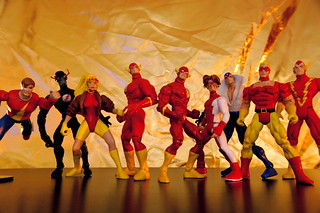 I’m working on a project that has a legitimate (non-spammy) reason to need cross-domain cookies, and we settled on flash as a good way to accomplish this.
I’m working on a project that has a legitimate (non-spammy) reason to need cross-domain cookies, and we settled on flash as a good way to accomplish this.
However, I was surprisingly unable to find any complete library or how-to guide for connecting flash cookies to javascript. So I dusted off my flash skills and built one, and and now you get to enjoy the fruit of my labor:
Download the swf, js, and source code from github
Or install via Bower:
bower install javascript-flash-cookiesThis is an .swf file that communicates with JavaScript via flash’s ExternalInerface to read and write to a Local SharedObject (LSO). Essentially, it’s cross-domain cookies for javascript.
It also includes an (optional) javascript library that handles embedding, communication, error checking, and logging.
The project is hosted at github: http://github.com/nfriedly/Javascript-Flash-Cookies
Working Example
See https://nfriedly.com/stuff/swfstore-example/ and http://nfriedly.github.com/Javascript-Flash-Cookies/ for a working example.
Quick start guide
To use the library, upload the storage.swf & swfstore.js files to your web server and put this HTML and JavaScript into your web page(s):
The HTML
<!-- This example uses jquery, but SwfStore does not require jquery to work. -->
<script src="https://ajax.googleapis.com/ajax/libs/jquery/1.4.2/jquery.min.js"></script>
<script src="/PATH/TO/swfstore.js"></script>
<input id="dataInput" /> <input id="saveBtn" type="submit" value="Save" />
<div id="status"></div>
And The JavaScript
// wait until the page has finished loading before starting
$(function(){
// first disable things while the swfStore is initializing
$('input').attr("disabled","disabled");
$('#status').text('Loading...');
var mySwfStore = new SwfStore({
// Optional but recommended. Try to choose something unique.
namespace: 'myExample',
// To work cross-domain, only one of your sites should have the
// .swf, all other sites should load it from the first one
swf_url: //site.com/PATH/TO/storage.swf',
// Logs messages to the console if available, a div at the
// bottom of the page otherwise.
debug: true,
onready: function(){
// Now that the swfStore was loaded successfully, re-enable
$('input').removeAttr("disabled");
// Read the existing value (if any)
$('#dataInput').val(mySwfStore.get('myKey'));
// Set up an onclick handler to save the text to the
// swfStore whenever the Save button is clicked
$('#saveBtn').click(function(){
mySwfStore.set('myKey', $('#dataInput').val() );
$('#status').text('Saved!')
});
$('#status').text('Loaded');
},
onerror: function(){
// In case we had an error. (The most common cause is that
// the user disabled flash cookies.)
$('#status').text('Error');
}
});
});
Cross-domain usage
A copy of storage.swf located on one domain may be embedded on pages from one or more other domains, allowing cross-domain cookie access.
Security notes
By default, any website on the internet can access the data stored in these flashcookies.
Also, versions prior to 1.9.1 were vulnerable to an XSS bug and should not be used.
Troubleshooting 
- Be sure the urls to the .swf file and .js file are both correct.
- If the .swf file is unable to communicate with the JavaScript, it will display log messages on the flash object. If debug is enabled, this this should be visible on the page.
- To hide the flash object and disable the log messages appending to the bottom of the page, set debug to false. (Log messages are added to a
<div>if no console is found). - If the user does not have flash installed, the onerror function will be called after a (configurable) 10 second timeout. You may want to use a library such as Flash Detect to check for this more quickly. Flash Player 9.0.31.0 or newer is required.
- If you pass a non-string data as the key or value, things may break. Your best bet is to use strings and/or use JSON to encode objects as strings.
- If you see the error
uncaught exception: Error in Actionscript. Use a try/catch block to find error., try using//in the .swf URL rather thanhttps://. See https://github.com/nfriedly/Javascript-Flash-Cookies/issues/14 for more information. - Do not set
display:noneon the swf or any of it's parent elements, this will cause the file to not render and the timeout will be fired. Disable debug and it will be rendered off screen. - The error
this.swf.set is not a functionhas been known to occur when the FlashFirebug plugin is enabled in Firefox / Firebug...
Bugs and patches
Bug reports and patches are always welcome at github (preferred), or just send me an email. I'll also consider new features, but I'm generally going to prioritize keeping this library small and simple, so most new features will be refused.